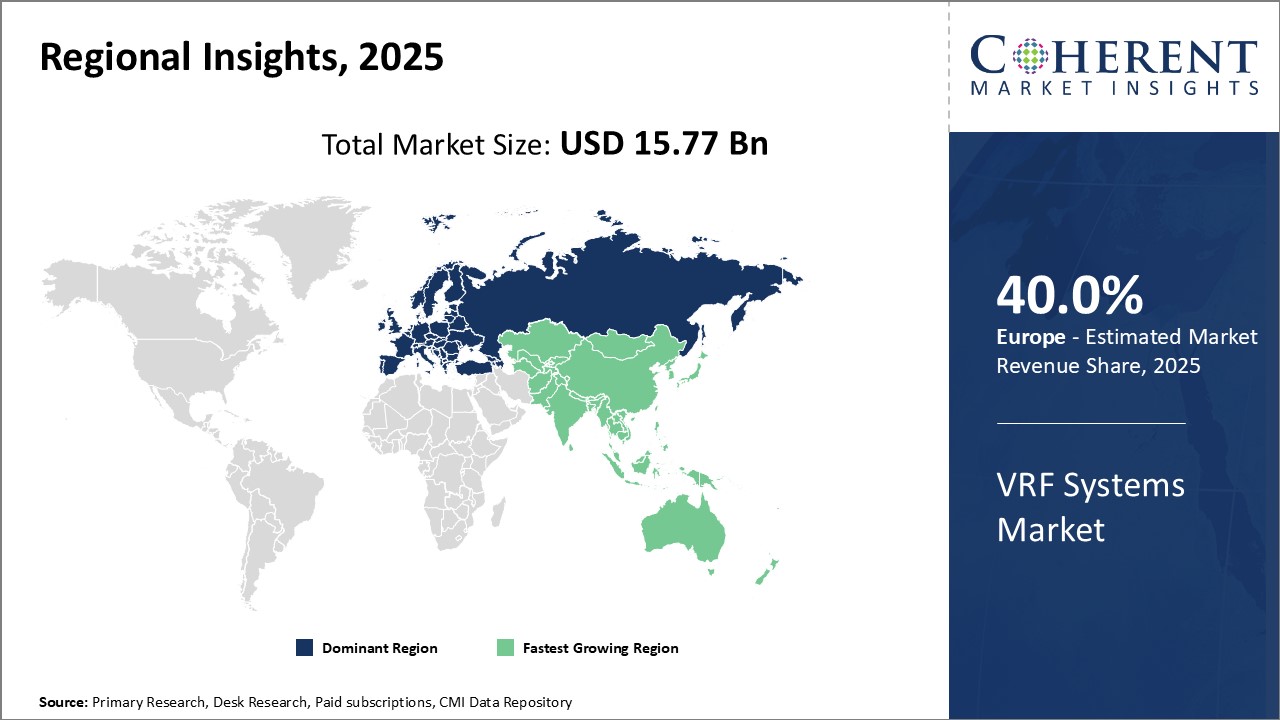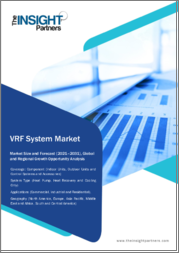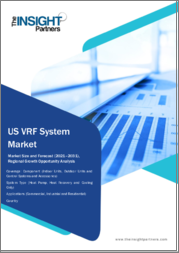
|
시장보고서
상품코드
1671935
VRF 시스템 시장 : 유형별, 컴포넌트별, 최종사용자별, 지역별VRF Systems Market, By Type, By Component, By End User, By Geography |
||||||
세계의 VRF 시스템 시장 규모는 2025년에 157억 7,000만 달러로 추정되며, 2032년에는 325억 4,000만 달러에 달할 것으로 예측되며, 2025-2032년 연간 평균 성장률(CAGR)은 10.9%로 추이할 것으로 예측됩니다.
| 리포트 범위 | 리포트 상세 | ||
|---|---|---|---|
| 기준연도 | 2024 | 2025년 시장 규모 | 157억 7,000만 달러 |
| 실적 데이터 | 2020-2024년 | 예측 기간 | 2025-2032년 |
| 예측 기간 : 2025-2032년 CAGR : | 10.90% | 2032년 가치 예측 | 325억 4,000만 달러 |

가변 냉매 플로우(VRF) 시스템은 난방, 환기 및 공조(HVAC) 업계의 첨단 기술로, 하나의 시스템에서 동시에 냉난방을 수행하는 기술입니다. 이 시스템은 냉매를 냉난방 매체로 사용하며, 소구경 파이프를 통해 여러 실내 유닛에 냉매를 분배합니다. 에너지 효율 향상, 개별 구역 제어, 설계 및 설치 유연성 등 기존 분할 에어컨에 비해 다양한 장점이 있습니다. 상업용 건축물 증가, 호텔 및 소매 업계의 효율적이고 지속가능한 냉난방 솔루션에 대한 수요 증가, 시스템 설계의 유연성에 대한 요구 증가 등의 요인이 예측 기간 중 VRF 시스템에 대한 세계 수요를 견인할 것으로 예상됩니다.
시장 역학:
세계 VRF 시스템 시장은 특히 아시아태평양 및 라틴아메리카의 신흥 경제 지역에서 급속한 도시화 및 산업화 활동과 같은 요인에 의해 주도되고 있습니다. 이는 상업용 건물의 건설 활동을 가속화하고 있으며, 첨단이고 효율적인 HVAC 솔루션에 대한 수요를 증가시키고 있습니다. 또한 건물 소유주와 건설업체들이 지속가능하고 에너지 효율적인 인프라에 중점을 두면서 VRF 시스템과 같은 그린 빌딩 기술에 대한 비즈니스 기회가 창출되고 있습니다. 그러나 기존 공조 시스템에 비해 초기 도입 비용이 높다는 점이 이 시장의 성장을 저해하는 주요 요인으로 작용하고 있습니다. 그럼에도 불구하고 주거용도에 맞는 보다 맞춤형의 비용 효율적인 VRF 기기 개발을 위한 연구개발이 진행되고 있으며, 향후 수년간 새로운 길이 열릴 것으로 예상됩니다.
본 조사의 주요 특징
세계의 VRF 시스템 시장에 대해 조사 분석했으며, 2024년을 기준 연도로 하여 예측 기간(2025-2032년) 시장 규모(10억 달러)와 연평균 성장률(CAGR)을 조사하여 전해드립니다.
또한 다양한 부문에 걸친 잠재적 매출 기회를 밝히고, 이 시장의 매력적인 투자 제안 매트릭스를 설명합니다.
또한 시장 성장 촉진요인, 억제요인, 기회, 신제품 출시 및 승인, 시장 동향, 지역별 전망, 주요 기업의 경쟁 전략 등에 대한 중요한 인사이트를 제공합니다.
이 보고서는 기업 하이라이트, 제품 포트폴리오, 주요 하이라이트, 성과, 전략 등의 매개 변수를 기반으로 세계 VRF 시스템 시장의 주요 기업을 프로파일링합니다.
이 보고서의 인사이트를 통해 마케팅 담당자와 기업 경영진은 향후 제품 출시, 유형화, 시장 확대, 마케팅 전략에 대한 정보에 입각한 의사결정을 내릴 수 있습니다.
이 보고서는 투자자, 공급업체, 제품 제조업체, 유통업체, 신규 시장 진출기업, 재무 분석가 등 업계의 다양한 이해관계자를 대상으로 합니다.
이해관계자들은 세계 VRF 시스템 시장 분석에 사용되는 다양한 전략 매트릭스를 통해 의사결정을 쉽게 내릴 수 있습니다.
목차
제1장 조사의 목적과 전제조건
- 조사 목적
- 전제조건
- 약어
제2장 시장 전망
- 리포트 설명
- 시장의 정의와 범위
- 개요
제3장 시장 역학, 규제, 동향 분석
- 시장 역학
- 영향 분석
- 주요 하이라이트
- 규제 시나리오
- 제품 발매/승인
- PEST 분석
- PORTER의 산업 분석
- 시장 기회
- 규제 시나리오
- 주요 발전
- 업계 동향
제4장 세계의 VRF 시스템 시장, 유형별, 2020-2032년, (10억 달러)
- 히트펌프 시스템
- 열회수 시스템
- 멀티 스플릿 시스템
- 기타
제5장 세계의 VRF 시스템 시장, 컴포넌트별, 2020-2032년, (10억 달러)
- 야외 유닛
- 실내 유닛
- 제어 시스템과 액세서리
- 기타
제6장 세계의 VRF 시스템 시장, 최종사용자별, 2020-2032년, (10억 달러)
- 주택
- 상업
- 산업
제7장 세계의 VRF 시스템 시장, 지역별, 2020-2032년, 가치(10억 달러)
- 북미
- 라틴아메리카
- 유럽
- 아시아태평양
- 중동
- 아프리카
제8장 경쟁 구도
- Daikin Industries, Ltd.
- Mitsubishi Electric Corporation
- LG Electronics
- Panasonic Corporation
- Toshiba Carrier Corporation
- Fujitsu General Limited
- Hitachi, Ltd.
- Samsung Electronics
- Trane Technologies
- Johnson Controls International plc
- Rheem Manufacturing Company
- Carrier Global Corporation
- Lennox International Inc.
- Midea Group
- Gree Electric Appliances, Inc.
제9장 애널리스트의 권장사항
제10장 참고 문헌과 조사 방법
- 참고 문헌
- 조사 방법
- 출판사 소개
Global VRF Systems Market is estimated to be valued at US$ 15.77 Bn in 2025 and is expected to reach US$ 32.54 Bn by 2032, growing at a compound annual growth rate (CAGR) of 10.9% from 2025 to 2032.
| Report Coverage | Report Details | ||
|---|---|---|---|
| Base Year: | 2024 | Market Size in 2025: | US$ 15.77 Bn |
| Historical Data for: | 2020 To 2024 | Forecast Period: | 2025 To 2032 |
| Forecast Period 2025 to 2032 CAGR: | 10.90% | 2032 Value Projection: | US$ 32.54 Bn |

Variable Refrigerant Flow (VRF) system is an advanced technology in the heating, ventilation, and air conditioning (HVAC) industry that provides simultaneous heating and cooling through a single system. The system uses refrigerant as the heating and cooling medium and distributes it through small bore pipes to multiple indoor units. It offers various advantages over the conventional split air-conditioning units such as improved energy efficiency, individual zone control, and flexibility in design and installation. Factors such as growth in commercial construction activities, increasing demand for efficient and sustainable cooling and heating solutions from the hospitality and retail sectors, and rising need for flexibility in system designs are expected to drive the demand for VRF systems globally over the forecast period.
Market Dynamics:
The global VRF systems market is driven by factors such as rapid urbanization and industrialization activities especially across emerging economies of Asia Pacific and Latin America. This has accelerated the commercial construction activities, which, in turn, is fueling the demand for advanced and efficient HVAC solutions. Additionally, the growing focus of building owners and constructors towards sustainable and energy-efficient infrastructure is creating opportunities for green building technologies like VRF systems. However, high initial installation cost compared to conventional air conditioning systems is a major factor restraining the growth of this market. Nevertheless, ongoing R&D towards development of more customized and cost-effective VRF equipment tailored for residential applications is expected to create new avenues over the coming years.
Key Features of the Study:
This report provides in-depth analysis of the global VRF systems market, and provides market size (USD Bn) and compound annual growth rate (CAGR%) for the forecast period (2025-2032), considering 2024 as the base year
It elucidates potential revenue opportunities across different segments and explains attractive investment proposition matrices for this market
This study also provides key insights about market drivers, restraints, opportunities, new product launches or approvals, market trends, regional outlook, and competitive strategies adopted by key players
It profiles key players in the global VRF systems market based on the following parameters - company highlights, products portfolio, key highlights, financial performance, and strategies
Key companies covered as a part of this study include Daikin Industries, Ltd., Mitsubishi Electric Corporation, LG Electronics, Panasonic Corporation, Toshiba Carrier Corporation, Fujitsu General Limited, Hitachi, Ltd., Samsung Electronics, Trane Technologies, Johnson Controls International plc, Rheem Manufacturing Company, Carrier Global Corporation, Lennox International Inc., Midea Group, and Gree Electric Appliances, Inc.
Insights from this report would allow marketers and the management authorities of the companies to make informed decisions regarding their future product launches, type up-gradation, market expansion, and marketing tactics
The global VRF systems market report caters to various stakeholders in this industry including investors, suppliers, product manufacturers, distributors, new entrants, and financial analysts
Stakeholders would have ease in decision-making through various strategy matrices used in analyzing the global VRF systems market
Market Segmentation
- Type Insights (Revenue, USD Bn, 2020 - 2032)
- Heat Pump Systems
- Heat Recovery Systems
- Multi-Split Systems
- Others
- Component Insights (Revenue, USD Bn, 2020 - 2032)
- Outdoor Units
- Indoor Units
- Control Systems and Accessories
- Others
- End User Insights (Revenue, USD Bn, 2020 - 2032)
- Residential
- Commercial
- Industrial
- Regional Insights (Revenue, USD Bn, 2020 - 2032)
- North America
- U.S.
- Canada
- Latin America
- Brazil
- Argentina
- Mexico
- Rest of Latin America
- Europe
- Germany
- U.K.
- Spain
- France
- Italy
- Russia
- Rest of Europe
- Asia Pacific
- China
- India
- Japan
- Australia
- South Korea
- ASEAN
- Rest of Asia Pacific
- Middle East
- GCC Countries
- Israel
- Rest of Middle East
- Africa
- South Africa
- North Africa
- Central Africa
- Key Players Insights
- Daikin Industries, Ltd.
- Mitsubishi Electric Corporation
- LG Electronics
- Panasonic Corporation
- Toshiba Carrier Corporation
- Fujitsu General Limited
- Hitachi, Ltd.
- Samsung Electronics
- Trane Technologies
- Johnson Controls International plc
- Rheem Manufacturing Company
- Carrier Global Corporation
- Lennox International Inc.
- Midea Group
- Gree Electric Appliances, Inc.
Table of Contents
1. Research Objectives and Assumptions
- Research Objectives
- Assumptions
- Abbreviations
2. Market Purview
- Report Description
- Market Definition and Scope
- Executive Summary
- Global VRF Systems Market, By Type
- Global VRF Systems Market, By Component
- Global VRF Systems Market, By End User
- Global VRF Systems Market, By Region
3. Market Dynamics, Regulations, and Trends Analysis
- Market Dynamics
- Impact Analysis
- Key Highlights
- Regulatory Scenario
- Product Launches/Approvals
- PEST Analysis
- PORTER's Analysis
- Market Opportunities
- Regulatory Scenario
- Key Developments
- Industry Trend
4. Global VRF Systems Market, By Type, 2020-2032, (USD Bn)
- Introduction
- Market Share Analysis, 2025 and 2032 (%)
- Y-o-Y Growth Analysis, 2021 - 2032
- Segment Trends
- Heat Pump Systems
- Introduction
- Market Size and Forecast, and Y-o-Y Growth, 2020-2032, (USD Bn)
- Heat Recovery Systems
- Introduction
- Market Size and Forecast, and Y-o-Y Growth, 2020-2032, (USD Bn)
- Multi-Split Systems
- Introduction
- Market Size and Forecast, and Y-o-Y Growth, 2020-2032, (USD Bn)
- Others
- Introduction
- Market Size and Forecast, and Y-o-Y Growth, 2020-2032, (USD Bn)
5. Global VRF Systems Market, By Component, 2020-2032, (USD Bn)
- Introduction
- Market Share Analysis, 2025 and 2032 (%)
- Y-o-Y Growth Analysis, 2021 - 2032
- Segment Trends
- Outdoor Units
- Introduction
- Market Size and Forecast, and Y-o-Y Growth, 2020-2032, (USD Bn)
- Indoor Units
- Introduction
- Market Size and Forecast, and Y-o-Y Growth, 2020-2032, (USD Bn)
- Control Systems and Accessories
- Introduction
- Market Size and Forecast, and Y-o-Y Growth, 2020-2032, (USD Bn)
- Others
- Introduction
- Market Size and Forecast, and Y-o-Y Growth, 2020-2032, (USD Bn)
6. Global VRF Systems Market, By End User, 2020-2032, (USD Bn)
- Introduction
- Market Share Analysis, 2025 and 2032 (%)
- Y-o-Y Growth Analysis, 2021 - 2032
- Segment Trends
- Residential
- Introduction
- Market Size and Forecast, and Y-o-Y Growth, 2020-2032, (USD Bn)
- Commercial
- Introduction
- Market Size and Forecast, and Y-o-Y Growth, 2020-2032, (USD Bn)
- Industrial
- Introduction
- Market Size and Forecast, and Y-o-Y Growth, 2020-2032, (USD Bn)
7. Global VRF Systems Market, By Region, 2020 - 2032, Value (USD Bn)
- Introduction
- Market Share (%) Analysis, 2025,2028 & 2032, Value (USD Bn)
- Market Y-o-Y Growth Analysis (%), 2021 - 2032, Value (USD Bn)
- Regional Trends
- North America
- Introduction
- Market Size and Forecast, By Type, 2020 - 2032, Value (USD Bn)
- Market Size and Forecast, By Component, 2020 - 2032, Value (USD Bn)
- Market Size and Forecast, By End User, 2020 - 2032, Value (USD Bn)
- Market Size and Forecast, By Country, 2020 - 2032, Value (USD Bn)
- U.S.
- Canada
- Latin America
- Introduction
- Market Size and Forecast, By Type, 2020 - 2032, Value (USD Bn)
- Market Size and Forecast, By Component, 2020 - 2032, Value (USD Bn)
- Market Size and Forecast, By End User, 2020 - 2032, Value (USD Bn)
- Market Size and Forecast, By Country, 2020 - 2032, Value (USD Bn)
- Brazil
- Argentina
- Mexico
- Rest of Latin America
- Europe
- Introduction
- Market Size and Forecast, By Type, 2020 - 2032, Value (USD Bn)
- Market Size and Forecast, By Component, 2020 - 2032, Value (USD Bn)
- Market Size and Forecast, By End User, 2020 - 2032, Value (USD Bn)
- Market Size and Forecast, By Country, 2020 - 2032, Value (USD Bn)
- Germany
- U.K.
- Spain
- France
- Italy
- Russia
- Rest of Europe
- Asia Pacific
- Introduction
- Market Size and Forecast, By Type, 2020 - 2032, Value (USD Bn)
- Market Size and Forecast, By Component, 2020 - 2032, Value (USD Bn)
- Market Size and Forecast, By End User, 2020 - 2032, Value (USD Bn)
- Market Size and Forecast, By Country, 2020 - 2032, Value (USD Bn)
- China
- India
- Japan
- Australia
- South Korea
- ASEAN
- Rest of Asia Pacific
- Middle East
- Introduction
- Market Size and Forecast, By Type, 2020 - 2032, Value (USD Bn)
- Market Size and Forecast, By Component, 2020 - 2032, Value (USD Bn)
- Market Size and Forecast, By End User, 2020 - 2032, Value (USD Bn)
- Market Size and Forecast, By Country, 2020 - 2032, Value (USD Bn)
- GCC Countries
- Israel
- Rest of Middle East
- Africa
- Introduction
- Market Size and Forecast, By Type, 2020 - 2032, Value (USD Bn)
- Market Size and Forecast, By Component, 2020 - 2032, Value (USD Bn)
- Market Size and Forecast, By End User, 2020 - 2032, Value (USD Bn)
- Market Size and Forecast, By Country/Region, 2020 - 2032, Value (USD Bn)
- South Africa
- North Africa
- Central Africa
8. Competitive Landscape
- Daikin Industries, Ltd.
- Company Highlights
- Product Portfolio
- Key Developments
- Financial Performance
- Strategies
- Mitsubishi Electric Corporation
- Company Highlights
- Product Portfolio
- Key Developments
- Financial Performance
- Strategies
- LG Electronics
- Company Highlights
- Product Portfolio
- Key Developments
- Financial Performance
- Strategies
- Panasonic Corporation
- Company Highlights
- Product Portfolio
- Key Developments
- Financial Performance
- Strategies
- Toshiba Carrier Corporation
- Company Highlights
- Product Portfolio
- Key Developments
- Financial Performance
- Strategies
- Fujitsu General Limited
- Company Highlights
- Product Portfolio
- Key Developments
- Financial Performance
- Strategies
- Hitachi, Ltd.
- Company Highlights
- Product Portfolio
- Key Developments
- Financial Performance
- Strategies
- Samsung Electronics
- Company Highlights
- Product Portfolio
- Key Developments
- Financial Performance
- Strategies
- Trane Technologies
- Company Highlights
- Product Portfolio
- Key Developments
- Financial Performance
- Strategies
- Johnson Controls International plc
- Company Highlights
- Product Portfolio
- Key Developments
- Financial Performance
- Strategies
- Rheem Manufacturing Company
- Company Highlights
- Product Portfolio
- Key Developments
- Financial Performance
- Strategies
- Carrier Global Corporation
- Company Highlights
- Product Portfolio
- Key Developments
- Financial Performance
- Strategies
- Lennox International Inc.
- Company Highlights
- Product Portfolio
- Key Developments
- Financial Performance
- Strategies
- Midea Group
- Company Highlights
- Product Portfolio
- Key Developments
- Financial Performance
- Strategies
- Gree Electric Appliances, Inc.
- Company Highlights
- Product Portfolio
- Key Developments
- Financial Performance
- Strategies
9. Analyst Recommendations
- Wheel of Fortune
- Analyst View
- Coherent Opportunity Map
10. References and Research Methodology
- References
- Research Methodology
- About us



















